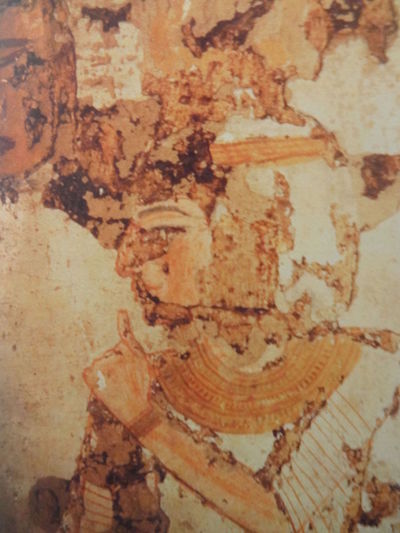KV 10 is the tomb of the short-lived king Amenmesse who tried to usurp the position of Seti II. It is located in the centre of the Valley of the Kings. He probably only ruled over Upper Egypt for around four years, so it is not surprising that he did not manage to complete his tomb.
KV 10 consists of an entrance hall featuring images of the king facing Re-Horakhty, followed by a corridor decorated with the Litany of Re and another decorated with scenes from the Amduat.
Beyond these descending corridors there is a well room (although the well itself had not been dug) and pillared chamber with a side room which was accidentally breached during the construction of KV 11 (Setnakhte / Ramesses III). A further two corridors descend from the pillared hall, but the burial chamber was never excavated.
The tomb follows the basic design of that of Merenptah, in both plan and decorative iconography. However, the angle of descent is much shallower than that of the tomb of Merenptah, and there are no stairs cut into the corridors.

When Amenmesse lost control of Thebes, and probably also lost his life, the carving had been completed as far as the pillared hall. Generally, in such circumstances, the name of the king was removed or replaced but the decorative elements were left intact. In this case, the carvings were sliced off the walls, leaving faint traces of the outlines which are easy to read where raised relief had been completed.
In many places, the cartouche of Amenmesse are remarkably easy to read despite the destruction. Dodson sees this as an attempt to “turn off “the magic of the tomb. However, Wilkinson has noted that it is not entirely clear to what extent the damage was conducted as part of a program of damnatio memoriae conducted against Amenmesse, and how much related to the refitting of the tomb for two royal women, Baketwernel and Takhat.

The fact that inner parts of the tomb were later adapted for Baketwernel and Takhat initially caused some confusion. It was proposed that Baketwernel was the wife of Amenmesse and Takhat was his mother. We know that his mother was indeed called Takhat, but it was a common name at the time, and it is now generally agreed they were not actually related. These burials probably date to the twentieth dynasty (around the reign of Ramesses IX). The outer corridors, well room and pillared hall were all plastered and painted with scenes of the women making offerings to a variety of deities along with scenes from the Book of the Dead and one scene featuring Osiris which is similar to the shrine from the tomb of Seti I (KV 17).
A fragment of limestone found in the tomb was initially thought to have been from the sarcophagus of Amenmesse, but this attribution is now considered doubtful as there is little other evidence that his burial took place. Given the circumstances of his rule, it is unlikely that Seti II would have undertaken to bury him.
A number of fragments of grave goods have been found in this tomb, notably:
- Fragments from the sarcophagus of Ramesses VI,
- Fragments of the canopic jars and part of a red limestone sarcophagus lid belonging to Takhat, and
- Fragments of canopic jars and a chest whose ownership has not been confirmed.
The tomb lay open in antiquity, with several pieces of classical graffiti and later Arabic texts around the entrance. This, unfortunately, allowed significant damage to the plaster, pillars, and decorations. It has been surveyed and mapped by Burton, Wilkinson, and Hay in the 1820s, Lepsius in 1845, Lefebure in 1883, Ayrton in 1907, and Schaden in the 1990s.
Bibliography
- Altenmuller, Hartwig (2016) “Royal Tombs of the Nineteenth Dynasty” from The Oxford Handbook of the Valley of the Kings Edited by Richard H. Wilkinson and Kent R. Weeks
- Dodson, Aiden (2016) The Royal Tombs of Ancient Egypt
- Reves, N and Wilkinson, R.H. (1996) The Complete Valley of the Kings
- Wilkinson, Richard H. Editor (2012) Tausret: Forgotten Queen and Pharaoh of Egypt
Copyright J Hill 2018